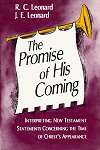Excerpt from the Introduction
For evangelical Christians, who subscribe to the inerrancy of the scriptural record, the New Testament’s affirmation of the imminent appearance of Christ and the end of the age presents a credibility problem. If it can be shown that all of the biblical writers and Jesus himself stated unequivocally that his coming and the end of the world were soon to occur, three possibilities present themselves: (1) they were mistaken, (2) they meant something other than what they appear to say, or (3) the end in fact occurred, just as they said it would.
Liberal interpreters, who have discarded the idea of an infallible Scripture, might accept the first option. Evangelicals, who believe the Bible does not make mistakes, could not. But this seems to force them to the position, however adroitly they may phrase it, that the New Testament writers gave a misleading impression to the people who first read their words and took them at face value. How else can one explain why a “coming” they said would take place in their own generation has yet to occur almost two millennia later?
But the third option remains. Perhaps Christ and the apostles meant exactly what they said, and they were correct. Perhaps the church has misunderstood what they meant by the coming of Christ and the end of the age. Did something indeed occur at the close of the New Testament era which was the very thing they predicted? A growing number of evangelical students of the Bible are receiving this third option, in one form or another. It is not a new viewpoint, but has historical precedent in Christian scholarship.
This study examines those statements of Jesus and the New Testament writers which relate, in particular, to the time of the parousia, and discusses the ways these time statements have been interpreted by students of eschatology along the lines of the three options described above. In drawing to a conclusion, the study further suggests a way to understand the coming of Christ in the ongoing life of the church, exploring possibilities expressed in the New Testament itself.
